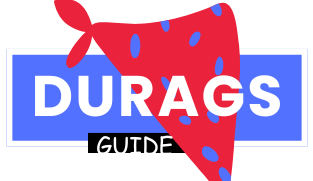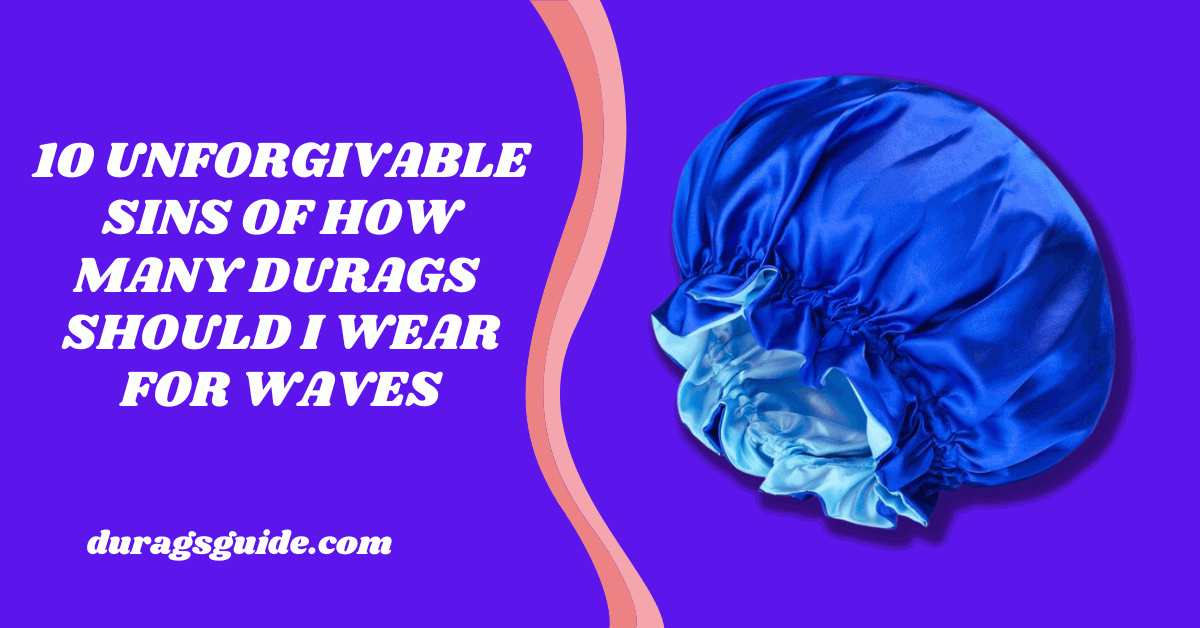
Introduction
Welcome to the ultimate guide on achieving flawless waves: “10 Unforgivable Sins of How Many Durags Should I Wear for Waves.” If you’ve ever wondered about the right number of durags to wear for perfect waves, you’re in the right place. In this article, we’ll delve into the dos and don’ts of durag usage, uncovering the secrets to wave mastery that will revolutionize your style game. Let’s dive in and uncover the keys to unlocking your wave potential!
The Ideal Number of Durags for Perfect Waves
To achieve the best results in wave development, the number of durags you utilize can be as crucial as the technique of tying them. Here’s a straightforward guide:
- Primary Durag: The main durag should be used primarily for sleeping to protect the waves and keep them intact overnight.
- Secondary Durag: This durag is used during showering to prevent water from disrupting the wave pattern and to protect the hair’s texture.
- Optional Third Durag: While not always necessary, a third durag can be employed for outdoor use. This helps in maintaining the hairstyle under various environmental conditions but is situational based on individual lifestyle and preferences .

Benefits of Layering Durags
Layering durags, often referred to as double ragging, involves wearing two durags or a durag with a stocking cap. This practice offers several benefits, particularly for those looking to maintain and enhance their 360 waves. Here are some of the key advantages:
1. Enhanced Wave Maintenance
Layering durags helps in maintaining 360 waves by keeping the hair firmly in place. This is particularly beneficial in various situations such as during sleep, when playing sports, or while swimming, ensuring that the waves are not disrupted.
2. Moisture Retention
Wearing durags to bed is crucial as it helps in retaining moisture in the hair. Moisture is vital for maintaining the integrity of waves and preventing the hair from drying out. Layering can enhance this effect by providing an additional layer of protection against moisture loss.
3. Protection From Elements
Durags offer protection against environmental elements such as sun, wind, and rain. This is especially important for individuals who spend a lot of time outdoors or are involved in activities like cycling where helmets are worn. Layering durags can provide extra protection, keeping the hairstyle intact and preventing damage from these element.
4. Improved Product Efficacy
Applying hair care products is a routine part of maintaining waves. Durags help in enhancing the effectiveness of these products by preventing them from evaporating too quickly. The layering of durags can extend this benefit, allowing the products to stay longer in the hair, which improves the hair’s texture and health.
5. Sweat Absorption
During physical activities, sweating is inevitable. Durags absorb sweat from the forehead and prevent it from dripping into the eyes or affecting the hairstyle. Layering durags increases this absorption capacity, thereby enhancing comfort and maintaining the look of the hairstyle during exercise.
6. Additional Compression
Layering durags provides extra compression, which is beneficial for wave formation. This increased compression helps in achieving better wave definition, making the waves more pronounced and aesthetically pleasing.
7. Overall Hair Protection
Besides maintaining waves, durags protect the hair from other potential damages such as sun exposure and frequent wetting during swimming. They also help in keeping braids and other hairstyles from becoming frizzy or undone during sleep.
By incorporating these practices into your hair care routine, you can significantly enhance the health and appearance of your waves, ensuring they are well-maintained and stylish.
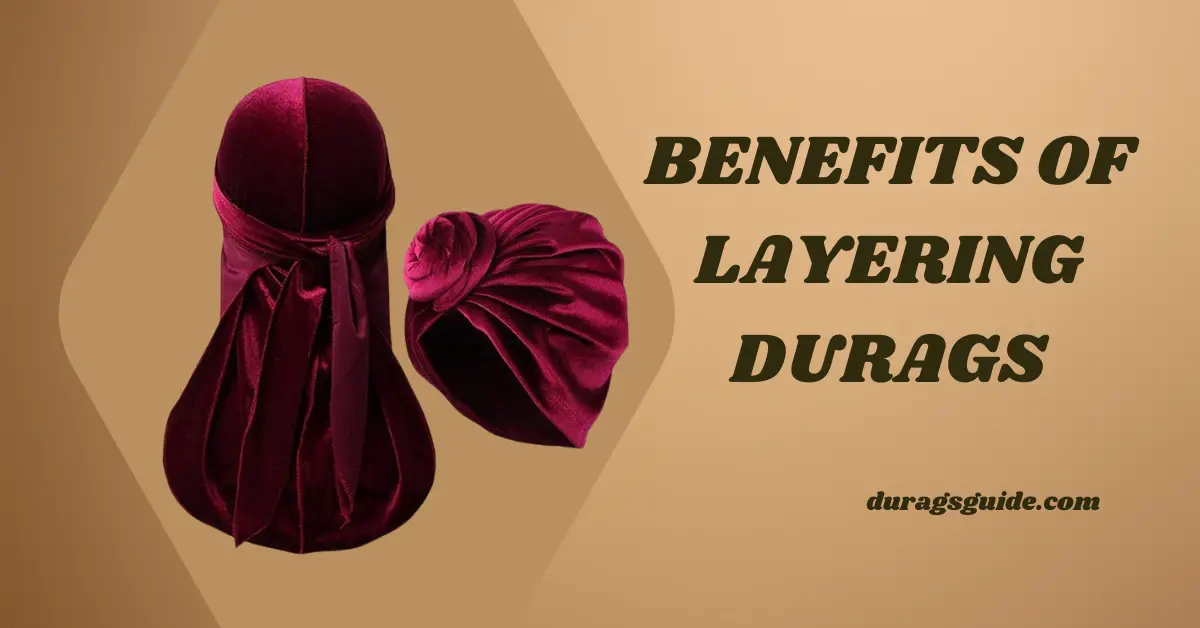
10 Unforgivable Sins Of How Many Durags Should I Wear For Waves
| Sin | Description |
| 1 | Overloading: Wearing too many durags at once can lead to discomfort and potential damage to your hairline and scalp. |
| 2 | Neglecting Moisture: Failure to moisturize your hair before wearing a durag can result in dryness and breakage, hindering wave formation. |
| 3 | Skipping Maintenance: Neglecting to wash and air dry your durag regularly can lead to product buildup and unpleasant odors. |
| 4 | Ignoring Comfort: Wearing a durag that is too tight or uncomfortable can cause scalp irritation and detract from the wave experience. |
| 5 | Impatience: Expecting overnight results and rushing the wave process can lead to frustration and disappointment. |
| 6 | Poor Material Choice: Opting for low-quality durags made from harsh materials can damage your hair and impede wave progress. |
| 7 | Inconsistent Wear: Failing to wear your durag consistently during rest periods can disrupt wave development and result in less defined waves. |
| 8 | Excessive Brushing: Overbrushing your waves can cause friction and breakage, leading to thinning and uneven wave patterns. |
| 9 | Ignoring Hair Texture: Neglecting to consider your hair texture when choosing durag materials and techniques can result in subpar wave results. |
| 10 | Lack of Personalization: Failing to tailor your wave routine to suit your unique preferences and lifestyle can hinder progress and motivation. |
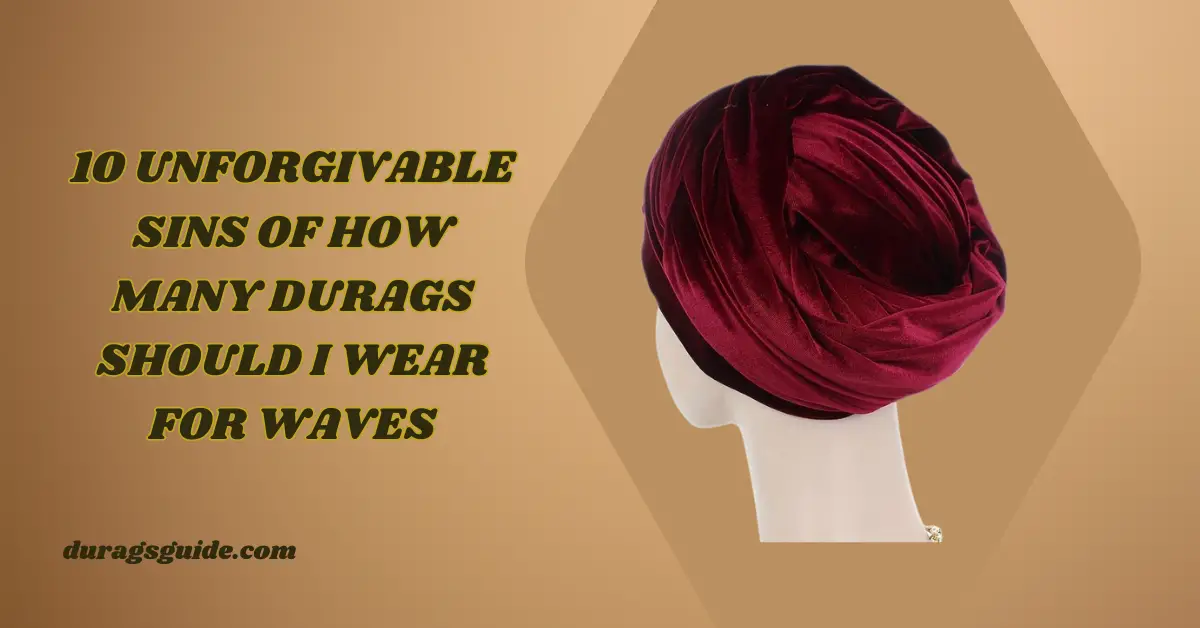
Wave Whisperer: Unraveling the Durag Mystery for Stunning Results
Durags have long been synonymous with the quest for flawless waves, but understanding their role in achieving this coveted hairstyle can feel like unraveling a mystery. In this section, we’ll shed light on the secrets of durags, exploring how they contribute to stunning wave results.
Durags act as a crucial tool in wave formation by providing compression and maintaining the desired pattern. Think of them as the sculptor’s hands shaping clay into a masterpiece. However, mastering their use requires more than just wrapping one around your head haphazardly.
To unravel the durag mystery, let’s first understand their basic function. Durags are typically made of silky or stretchy fabric and are designed to be worn tightly over the head. This tight fit applies pressure to the hair, encouraging it to lay flat and form waves. Additionally, durags help to lock in moisture and protect the hair from frizz and breakage, essential elements for healthy and vibrant waves.
But achieving stunning wave results goes beyond simply donning a durag. It’s about understanding the nuances of how they interact with your hair texture, length, and personal styling preferences. Different durag materials, styles, and tying techniques can yield varying results, making it essential to experiment and find what works best for you.
Furthermore, consistency is key when it comes to durag usage. Consistently wearing your durag during periods of rest and maintenance helps to train your hair into the desired wave pattern, ensuring long-lasting and defined results.

Durag Dos and Don’ts: Elevate Your Wave Game
In this section, we’ll explore the essential dos and don’ts of durag usage to help you elevate your wave game and achieve unparalleled results.
Dos:
- Choose the Right Material: Selecting the appropriate durag material is crucial for achieving optimal wave results. Satin and silk durags are highly recommended due to their smooth texture, which reduces friction and helps to prevent frizz. Avoid cotton durags, as they can absorb moisture from your hair, leading to dryness and potential breakage.
- Tie with Precision: How you tie your durag plays a significant role in the outcome of your waves. Ensure a snug yet comfortable fit by starting at the back of your head and wrapping the durag around in a diagonal direction. Avoid tying it too tightly, as this can cause discomfort and potentially damage your hairline.
- Establish a Routine: Consistency is key when it comes to durag usage. Incorporate wearing your durag into your daily routine, especially during periods of rest and maintenance. This helps to train your hair into the desired wave pattern and ensures that your waves stay defined and intact.
- Moisturize Regularly: Keeping your hair moisturized is essential for healthy wave formation. Use a hydrating hair moisturizer or wave pomade to nourish your hair and lock in moisture before wearing your durag. This helps to prevent dryness and breakage, ensuring that your waves remain vibrant and lustrous.
Don’ts:
- Overdo It: While wearing a durag is essential for wave formation, overdoing it can have adverse effects. Avoid wearing your durag excessively, as this can lead to scalp irritation, hairline damage, and even balding in severe cases. Aim for moderation and give your hair some time to breathe between durag sessions.
- Neglect Maintenance: Proper maintenance is crucial for preserving the integrity of your waves. Avoid neglecting your hair care routine and ensure that you wash and moisturize your hair regularly. Neglecting maintenance can lead to product buildup, dryness, and ultimately, less defined waves.
- Settle for Subpar Quality: Investing in high-quality durags is a worthwhile investment for achieving stunning wave results. Avoid settling for cheap, low-quality durags that may cause discomfort and fail to provide adequate compression. Opt for reputable brands known for their durability and effectiveness in wave formation.
By adhering to these dos and don’ts of durag usage, you can elevate your wave game and achieve stunning results that turn heads wherever you go. So, whether you’re a seasoned waver or just starting your wave journey, keep these tips in mind to unlock the full potential of your waves.
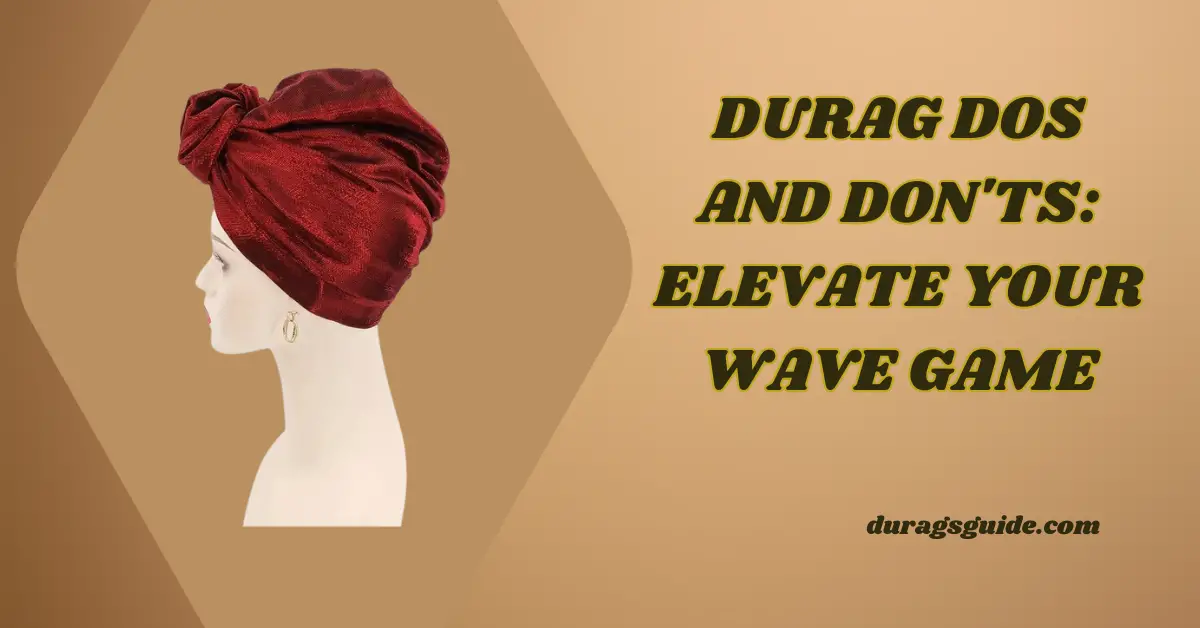
The Durag Debate: Finding the Perfect Balance for Waves
The debate over the number of durags to wear is a topic of much contention within the wave community. Some swear by wearing multiple durags simultaneously, believing that it enhances compression and accelerates wave development. Others advocate for a more conservative approach, arguing that wearing too many durags can lead to discomfort and potentially hinder wave progress.
To navigate this debate, it’s essential to consider the pros and cons of wearing multiple durags and assess how it aligns with your wave goals and personal preferences.
Pros of Multiple Durags:
- Enhanced Compression: Wearing multiple durags can increase the level of compression applied to your hair, encouraging it to lay flat and form defined waves more quickly.
- Increased Moisture Retention: Layering durags can help to lock in moisture and prevent it from escaping, resulting in hydrated and vibrant waves.
- Versatility: Experimenting with different combinations of durags allows you to customize the level of compression and coverage to suit your hair texture and wave goals.
Cons of Multiple Durags:
- Discomfort: Wearing multiple durags can feel restrictive and uncomfortable, especially if they are tied too tightly. This discomfort can detract from the overall wave experience and may discourage consistent durag usage.
- Potential Damage: Excessive compression from wearing multiple durags can put undue stress on your hairline and scalp, leading to irritation, hair breakage, and even balding in severe cases.
- Diminished Effectiveness: While wearing multiple durags may seem like a shortcut to faster wave development, it can actually hinder progress if not done properly. Improper compression and excessive pressure can disrupt the natural wave pattern and result in less defined waves over time.
Ultimately, the decision of how many durags to wear comes down to personal preference and comfort level. It’s essential to listen to your hair and adjust your durag routine accordingly to ensure optimal wave development and overall hair health.
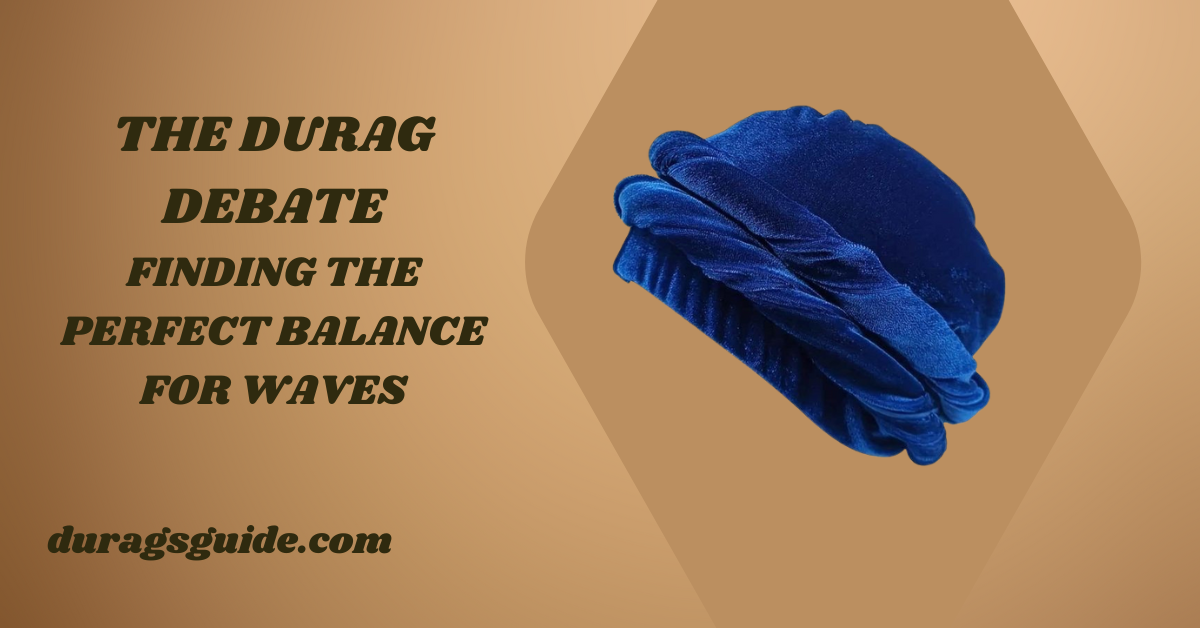
Optimal Durag Usage: Quality Over Quantity
When it comes to durag usage, the old adage “less is more” often rings true. While some may be tempted to layer multiple durags in the hopes of accelerating wave development, the key to success lies in prioritizing the quality of compression over the quantity of durags worn.
Here are some essential considerations for achieving optimal durag usage:
- Focus on Compression: The primary purpose of wearing a durag is to apply compression to your hair, encouraging it to lay flat and form defined waves. Instead of relying on multiple durags to achieve this, focus on achieving the right level of compression with a single durag. Ensure that it is tied snugly but comfortably to your head, applying gentle pressure evenly across your scalp.
- Choose Quality Over Quantity: Investing in a high-quality durag can make all the difference in your wave journey. Opt for durags made from premium materials like satin or silk, which offer superior smoothness and durability. Quality durags provide optimal compression without causing discomfort or irritation, allowing for consistent and effective wave development.
- Prioritize Comfort: Comfort should be a top priority when selecting and wearing a durag. Avoid the temptation to layer multiple durags in pursuit of faster results, as this can lead to discomfort and potential damage to your hairline and scalp. Instead, opt for a single durag that fits comfortably and securely, allowing you to wear it for extended periods without discomfort.
- Practice Patience: Achieving perfect waves takes time and patience, regardless of the number of durags you wear. Avoid rushing the process by overloading on durags or expecting overnight results. Consistency and dedication are key to wave development, so stick to a regular durag routine and trust in the process.
By prioritizing quality over quantity and focusing on achieving optimal compression with a single durag, you can streamline your wave routine and achieve superior results in less time. Remember, it’s not about how many durags you wear, but rather how effectively you use them to sculpt your waves with precision and care.
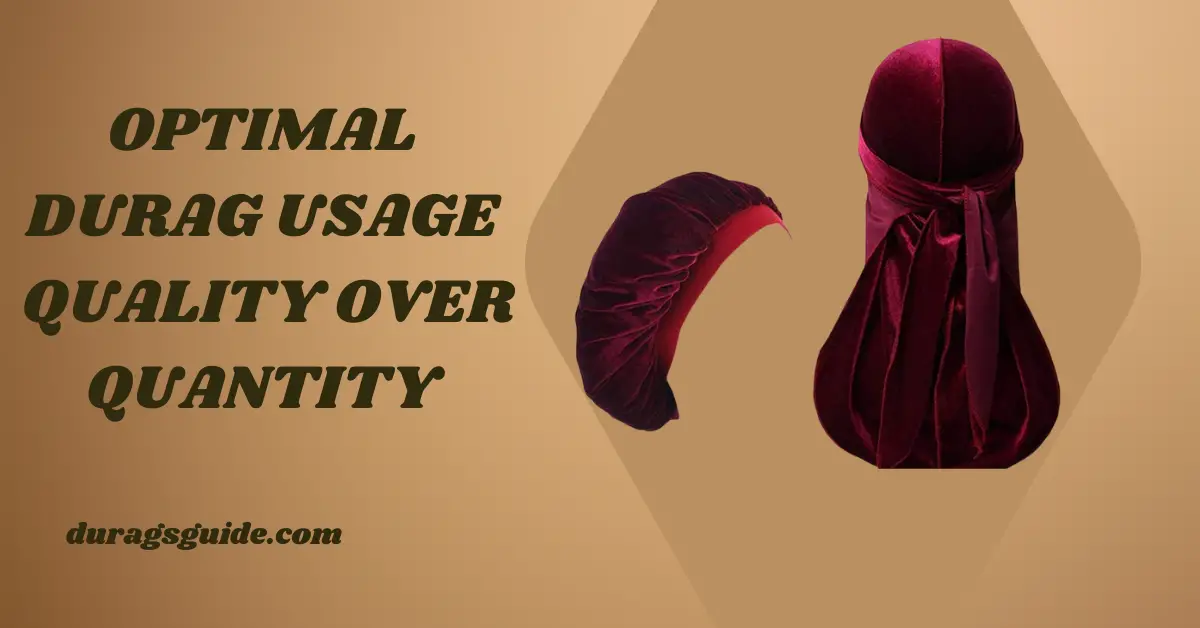
Understanding Hair Texture and Durag Impact
Hair texture plays a significant role in determining how effectively durags can help to create and maintain waves. Generally, hair textures can be categorized into three main types: straight, wavy, and curly. Each texture presents unique challenges and considerations when it comes to wave formation and durag usage.
- Straight Hair:
Straight hair tends to lay flat against the scalp, making it more challenging to create and maintain waves. Durags can be particularly beneficial for individuals with straight hair, as they help to apply pressure and encourage the hair to conform to the desired wave pattern. However, achieving defined waves with straight hair may require more time and effort compared to other hair textures.
- Wavy Hair:
Wavy hair features natural bends and curves that can enhance wave formation with the right durag usage. Durags can help to accentuate and define the natural waves in wavy hair, providing additional compression and support. Individuals with wavy hair may find that they achieve faster and more defined wave results with durags compared to those with straight hair.
- Curly Hair:
Curly hair presents its own set of challenges when it comes to wave formation and durag usage. The tight curls and coils in curly hair can make it more resistant to laying flat and forming defined waves. While durags can still be effective for individuals with curly hair, they may need to experiment with different tying techniques and durag materials to achieve optimal results.
Regardless of your hair texture, it’s essential to consider how durag usage can impact your wave journey. Here are some key tips for maximizing the effectiveness of durags based on your hair texture:
- Straight Hair: Focus on applying consistent and gentle pressure with your durag to encourage wave formation gradually over time.
- Wavy Hair: Embrace the natural waves in your hair and use durags to define and enhance their appearance for a more polished look.
- Curly Hair: Experiment with different durag tying techniques and materials to find what works best for your unique curl pattern and texture.
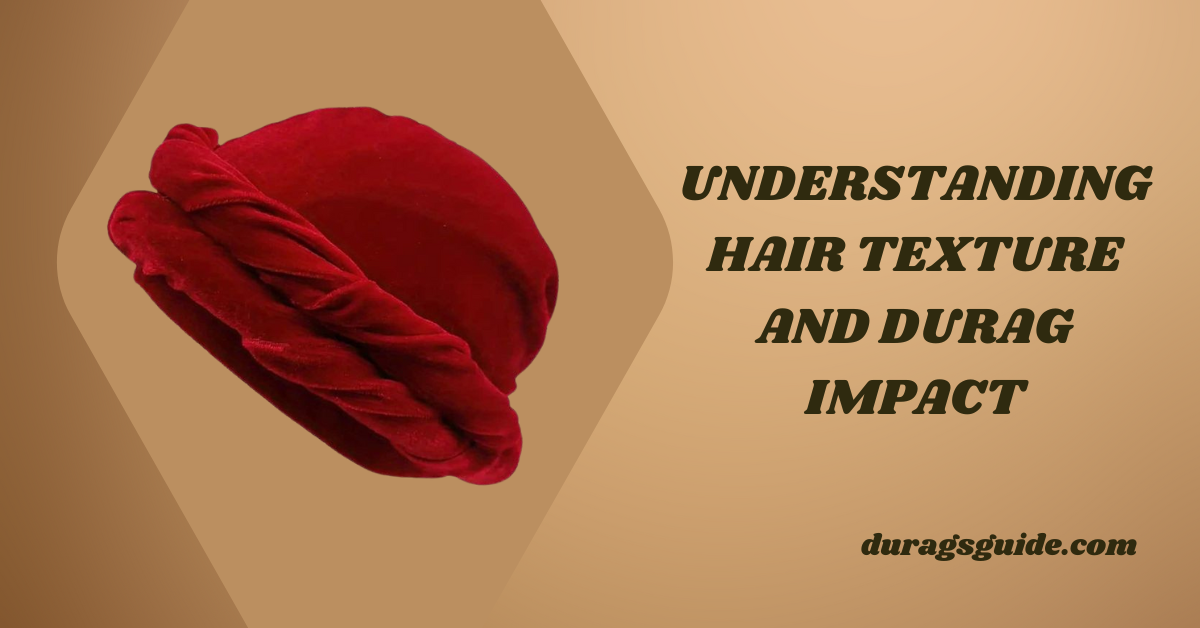
The Science Behind Durags and Wave Formation
Wave formation is a complex process influenced by various factors, including hair texture, moisture levels, and external stimuli such as durags. At its core, wave formation occurs when hair strands align and lay flat against the scalp in a consistent pattern, creating the characteristic “waves” seen in hairstyles.
Durags play a crucial role in wave formation by providing compression to the hair, encouraging it to conform to the desired wave pattern. The tight fit of a durag applies pressure evenly across the scalp, helping to smooth out hair strands and encourage them to lay flat.
But how exactly do durags achieve this compression, and what impact does it have on wave formation? Let’s delve into the science behind durags:
- Compression: The primary function of a durag is to apply compression to the hair, which refers to the force exerted on the hair strands to flatten them against the scalp. This compression helps to eliminate frizz, define the wave pattern, and create a uniform appearance.
- Material Properties: The material composition of a durag plays a significant role in its effectiveness in wave formation. Satin and silk durags are preferred for their smooth texture, which reduces friction and minimizes the risk of hair breakage. Additionally, these materials help to retain moisture in the hair, promoting healthy and vibrant waves.
- Moisture Retention: Durags also help to lock in moisture in the hair, preventing it from evaporating and causing dryness. Adequate moisture is essential for maintaining the elasticity and flexibility of the hair strands, allowing them to conform to the desired wave pattern more easily.
- Heat Retention: In addition to moisture retention, durags can also help to retain heat generated by the scalp. This mild heat encourages the hair cuticles to open, making them more receptive to shaping and styling. As a result, waves formed with the aid of a durag tend to be more defined and long-lasting.
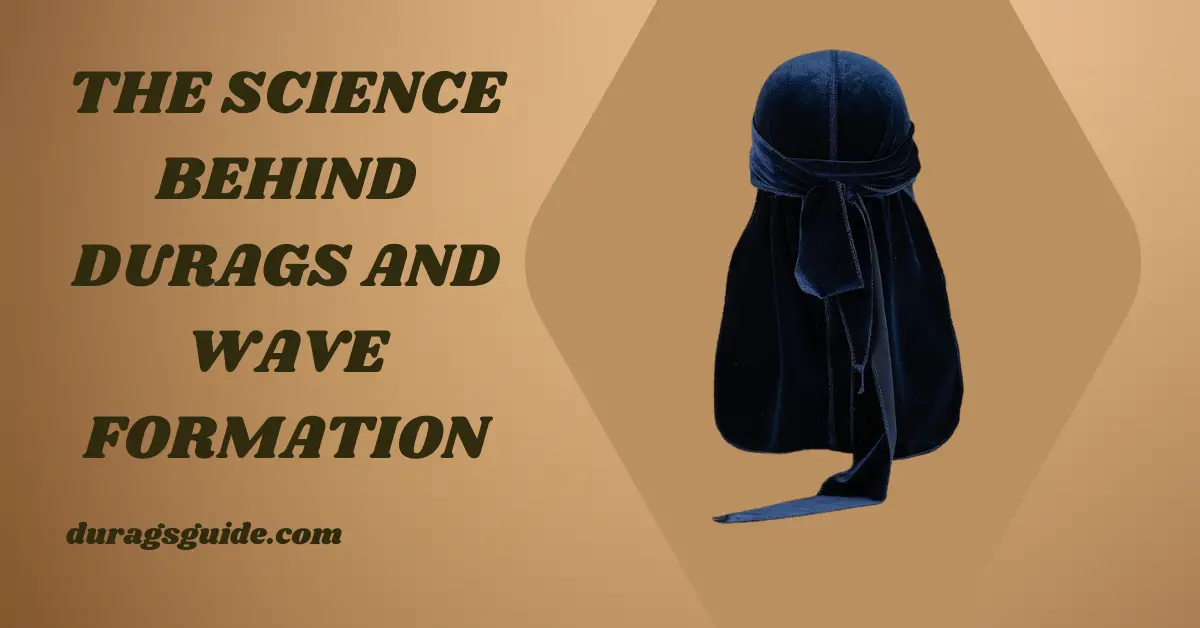
Avoiding Damage: Risks of Excessive Durag Wear
While durags are a valuable tool in wave formation, overdoing it can lead to various issues, including scalp irritation, hairline damage, and even balding. Understanding these risks is essential for maintaining healthy hair and achieving long-term wave success.
Scalp Irritation:
Wearing a durag for an extended period can lead to scalp irritation due to the constant pressure applied to the skin. This pressure can restrict blood flow to the scalp, leading to discomfort, itching, and even soreness. Prolonged irritation can also contribute to conditions such as folliculitis, a bacterial infection of the hair follicles, which can further exacerbate discomfort and inflammation.
To avoid scalp irritation, it’s essential to give your scalp a break from durag wear regularly. Remove your durag before bedtime and allow your scalp to breathe overnight. Additionally, choose durags made from breathable materials like satin or silk, which are less likely to trap heat and moisture against the scalp.
Hairline Damage:
Excessive durag wear can also damage the hairline, particularly if the durag is tied too tightly or worn for extended periods. Constant pressure on the hairline can lead to traction alopecia, a type of hair loss caused by repeated pulling or tension on the hair follicles. Signs of traction alopecia include thinning hair along the hairline and small, red bumps or sores.
To protect your hairline, avoid tying your durag too tightly and opt for looser, more comfortable tying techniques. If you notice any signs of hairline damage or thinning, take a break from durag wear and consult a dermatologist for personalized advice and treatment options.
Balding:
In severe cases, excessive durag wear can contribute to balding, particularly along the hairline and crown of the head. Traction alopecia caused by tight durag tying can lead to permanent hair loss if left untreated. Additionally, the constant pressure and friction from durag wear can weaken the hair follicles over time, leading to gradual thinning and shedding.
To prevent balding and maintain healthy hair, it’s essential to strike a balance with durag wear and avoid excessive compression. Rotate between different tying techniques and durag styles to minimize pressure on specific areas of the scalp. Additionally, prioritize scalp and hair health by maintaining a regular hair care routine and incorporating nourishing products into your regimen.
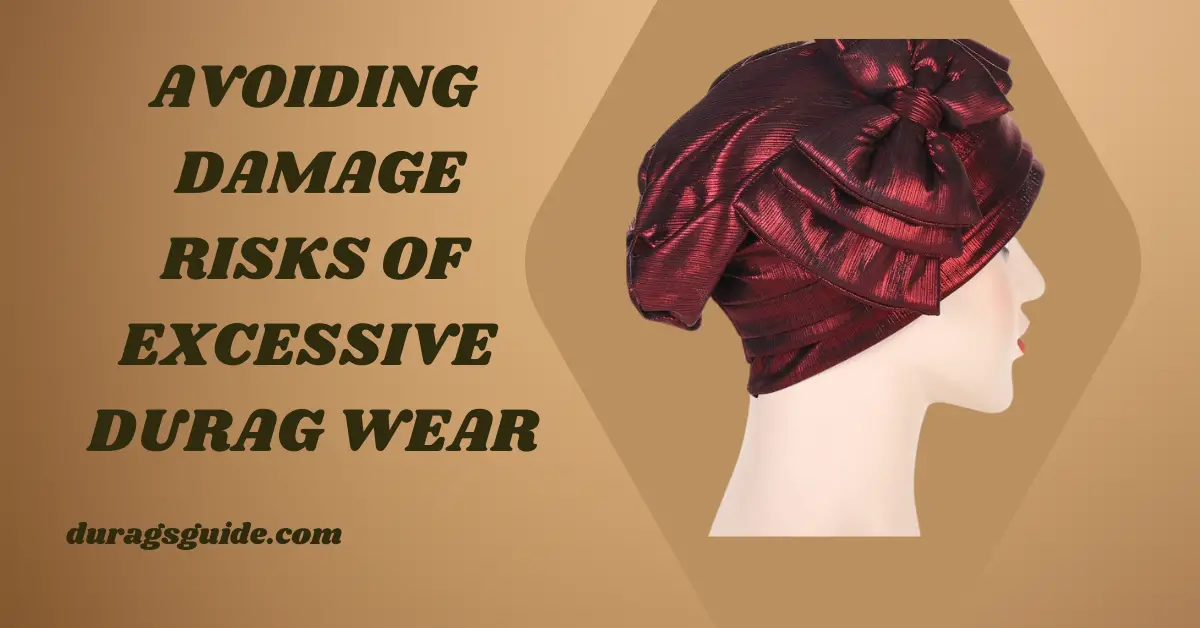
Achieving Waves: Balancing Durag Use with Other Techniques
While durags play a significant role in wave formation, they are just one piece of the puzzle. Incorporating a variety of techniques into your wave routine can help you achieve more defined, long-lasting waves.
Brushing:
Brushing is a fundamental technique in wave formation that helps to train the hair into the desired wave pattern. Using a wave brush with firm bristles, gently brush your hair in the direction of your waves, focusing on smoothing out any kinks or inconsistencies. Brushing helps to distribute natural oils throughout the hair, promoting shine and overall hair health.
Moisturizing:
Moisture is essential for maintaining healthy, vibrant waves. Incorporate moisturizing products such as wave pomades or moisturizing creams into your routine to keep your hair hydrated and nourished. Apply a small amount of product to damp hair and distribute it evenly using a brush or your fingertips. Focus on the ends of your hair, where dryness is most common, and avoid applying too much product to prevent buildup.
Wolfing:
Wolfing refers to the practice of allowing your hair to grow longer than usual between haircuts or trims. This extended growth period allows the hair to mature and develop deeper wave patterns. During the wolfing phase, it’s essential to maintain regular durag wear and brushing to keep your waves intact and prevent them from becoming unruly.
Scalp Massage:
Scalp massages stimulate blood flow to the scalp, promoting hair growth and overall scalp health. Incorporate scalp massages into your routine using your fingertips or a scalp massaging tool. Focus on gentle circular motions to relax the scalp muscles and improve circulation. Scalp massages can also help to distribute natural oils throughout the hair, reducing dryness and preventing breakage.
Edge Control:
Edge control products are designed to smooth and tame the edges of the hairline, creating a clean, polished look. Use edge control sparingly to define your edges and lay them flat against your scalp. Avoid applying too much product, as this can weigh down the hair and cause buildup. Instead, use a small amount and smooth it into place using a brush or your fingertips.
By balancing durag use with other wave techniques such as brushing, moisturizing, wolfing, scalp massages, and edge control, you can achieve more defined, long-lasting waves. Experiment with different techniques to find the combination that works best for your hair texture and wave goals. Remember, consistency and patience are key to achieving the waves of your dreams, so stick to your routine and enjoy the journey.

Personalizing Your Wave Journey: Factors to Consider
Waves are a highly individualized hairstyle, and what works for one person may not necessarily work for another. By understanding your unique hair texture, preferences, and lifestyle, you can tailor your wave routine to achieve the best possible results.
Hair Texture:
Hair texture plays a significant role in wave formation and determines the techniques and products that are most effective for achieving waves. Consider whether your hair is straight, wavy, or curly, as this will influence how your waves develop and the products you use to maintain them. For example, individuals with straight hair may need to use more compression and moisturizing products to encourage wave formation, while those with curly hair may need to focus on defining their natural curl pattern before transitioning to waves.
Lifestyle:
Your lifestyle also impacts your wave journey, as it determines how much time and effort you can dedicate to maintaining your waves. Consider factors such as your daily routine, job requirements, and activity level when developing your wave routine. If you lead a busy lifestyle, opt for low-maintenance wave techniques and products that require minimal upkeep. Conversely, if you have more time to dedicate to your waves, experiment with advanced techniques and products to achieve more defined results.
Preferences:
Personal preferences play a crucial role in shaping your wave journey and should be taken into account when developing your wave routine. Consider factors such as your preferred wave pattern, hairstyle, and grooming habits when selecting products and techniques for your waves. If you prefer a more natural look, opt for lighter products and looser wave patterns. If you prefer a more polished appearance, experiment with heavier products and tighter wave patterns to achieve a sleeker look.
Goals:
Finally, consider your wave goals when personalizing your wave journey. Are you aiming for deep, defined waves, or are you content with a more subtle wave pattern? Do you want to achieve waves quickly, or are you willing to invest more time and effort for long-term results? By setting clear goals for your wave journey, you can tailor your routine to align with your aspirations and track your progress along the way.
Ultimately, personalizing your wave journey is essential for achieving the best possible results. By considering factors such as your hair texture, lifestyle, preferences, and goals, you can develop a wave routine that is tailored to your unique needs and delivers the waves of your dreams. Experiment with different techniques and products, be patient with the process, and enjoy the journey as you watch your waves transform and evolve over time.
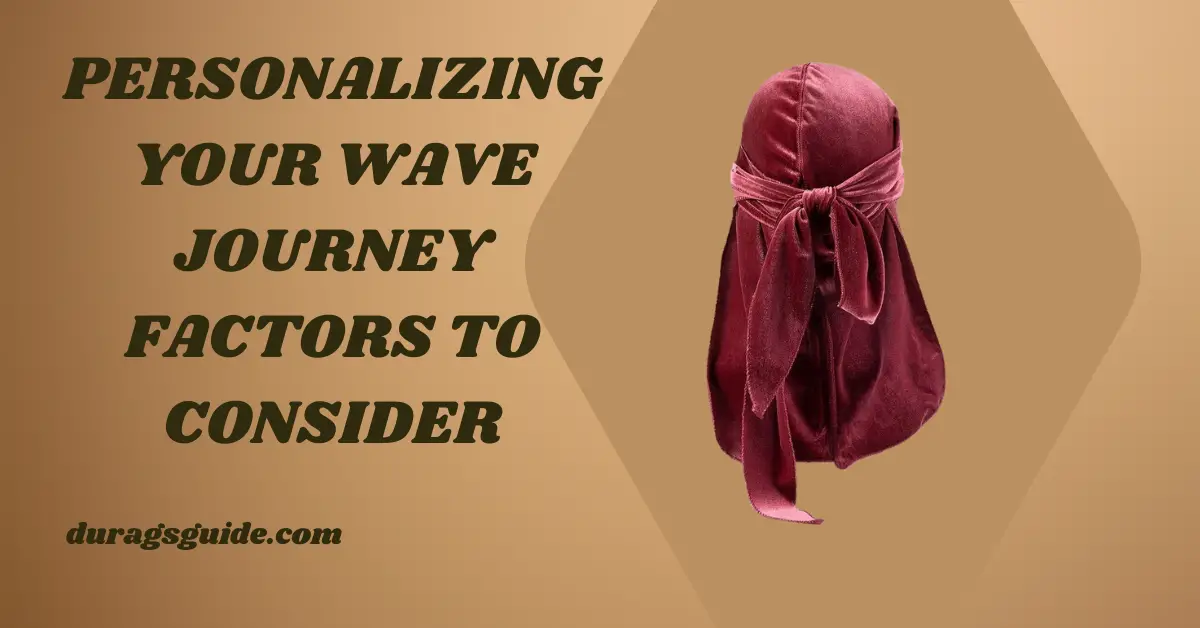
Mastering Waves: Durag Strategies for Success
Whether you’re a seasoned waver or just starting your wave journey, incorporating these expert tips into your durag routine can help you elevate your wave game to the next level.
Durag Material:
Choosing the right durag material is essential for achieving optimal wave results. Satin and silk durags are preferred for their smooth texture, which reduces friction and minimizes the risk of frizz. Additionally, these materials help to retain moisture in the hair, promoting healthy and vibrant waves. Invest in high-quality durags made from premium materials to maximize their effectiveness and durability.
Durag Tying Techniques:
Experimenting with different durag tying techniques can help you achieve the perfect fit and compression for your waves. Start by tying your durag snugly but comfortably around your head, ensuring that it covers your entire hairline and sits securely in place. Avoid tying your durag too tightly, as this can cause discomfort and potentially damage your hairline. Practice different tying techniques to find the one that works best for your hair texture and personal preferences.
Durag Maintenance:
Proper durag maintenance is essential for preserving its effectiveness and prolonging its lifespan. Wash your durag regularly using mild detergent and lukewarm water to remove dirt, oils, and product buildup. Avoid using harsh chemicals or bleach, as these can damage the fabric and affect its performance. Hang your durag to air dry completely before wearing it again to prevent mold and mildew growth.
Durag Rotation:
Rotating between multiple durags can help you maintain a consistent wave pattern and prevent wear and tear on a single durag. Invest in several durags in different colors or styles and rotate them regularly to distribute wear evenly. This also allows you to wash and air dry your durags between uses, ensuring that they remain clean and fresh.
Durag Night Routine:
Incorporating durag wear into your nightly routine is essential for preserving your waves and preventing them from becoming unruly overnight. Before bed, apply a small amount of wave pomade or moisturizer to your hair and brush it into place using a wave brush. Then, tie your durag securely around your head, making sure that it covers your entire hairline and stays in place throughout the night. This helps to lock in moisture and maintain the integrity of your waves while you sleep.
By mastering these durag strategies and techniques, you can take your wave game to new heights and achieve flawless, long-lasting waves. Experiment with different materials, tying techniques, and maintenance routines to find the combination that works best for you. With dedication, patience, and a little bit of trial and error, you can unlock the full potential of your waves and enjoy a stylish and confident appearance every day.
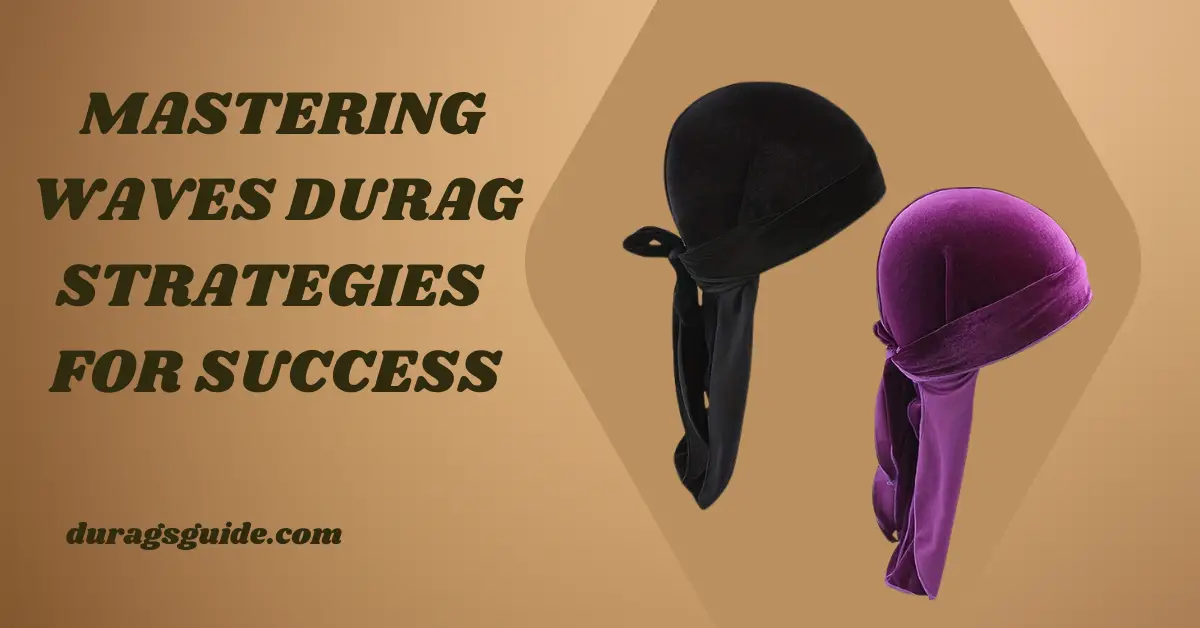
Conclusion
In conclusion, mastering the art of waves with durags requires a combination of knowledge, technique, and dedication. By delving into the intricacies of durag usage, understanding the science behind wave formation, and personalizing your approach to suit your unique hair texture and preferences, you can achieve stunning results that turn heads and boost your confidence. Remember, wave mastery is a journey, not a destination. Embrace the process, be patient with yourself, and continue to refine your durag routine as you strive for wave perfection. With perseverance and the expert strategies outlined in this article, you’re well-equipped to conquer your wave goals and showcase a stylish, wave-filled look that’s uniquely yours.
FAQS
How often should I wear durag for waves?
Wearing a durag consistently during sleep and maintenance periods is key for training your hair into the desired wave pattern. Aim to wear it nightly and during grooming routines for optimal results.
Is it OK to wear 2 durags?
Wearing two durags simultaneously can provide additional compression, but be cautious of excessive pressure on your hairline and scalp. Experiment with comfort and effectiveness, and avoid prolonged wear to prevent discomfort or damage.
Do durags give you waves?
Durags play a crucial role in wave formation by applying pressure to the hair, encouraging it to lay flat and form defined waves. However, consistent wear and proper technique are necessary for optimal results in achieving waves.
How to do 360 waves?
To achieve 360 waves, brush your hair in a consistent pattern, moisturize regularly, and wear a durag to maintain compression, fostering the desired wave pattern. Consistency and patience are key to achieving defined 360 waves.
How long should I keep my durag on for waves
Keep your durag on for at least 30 minutes to an hour after applying products and brushing, ensuring optimal compression for wave formation. Avoid wearing it excessively to prevent discomfort or potential damage to your hairline.
How long should I keep my hair for waves?
Maintain your hair length at around 1.5 to 2 inches for optimal wave formation, allowing enough length to train the hair into defined waves while still manageable for brushing and styling. Consistency in hair length aids in achieving uniform waves across the scalp.
